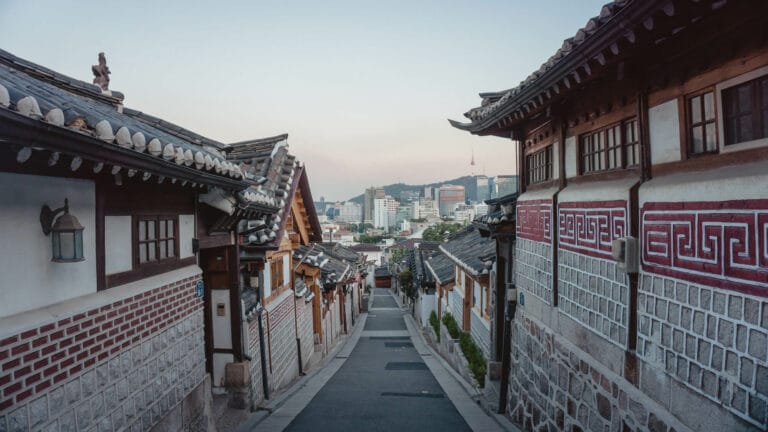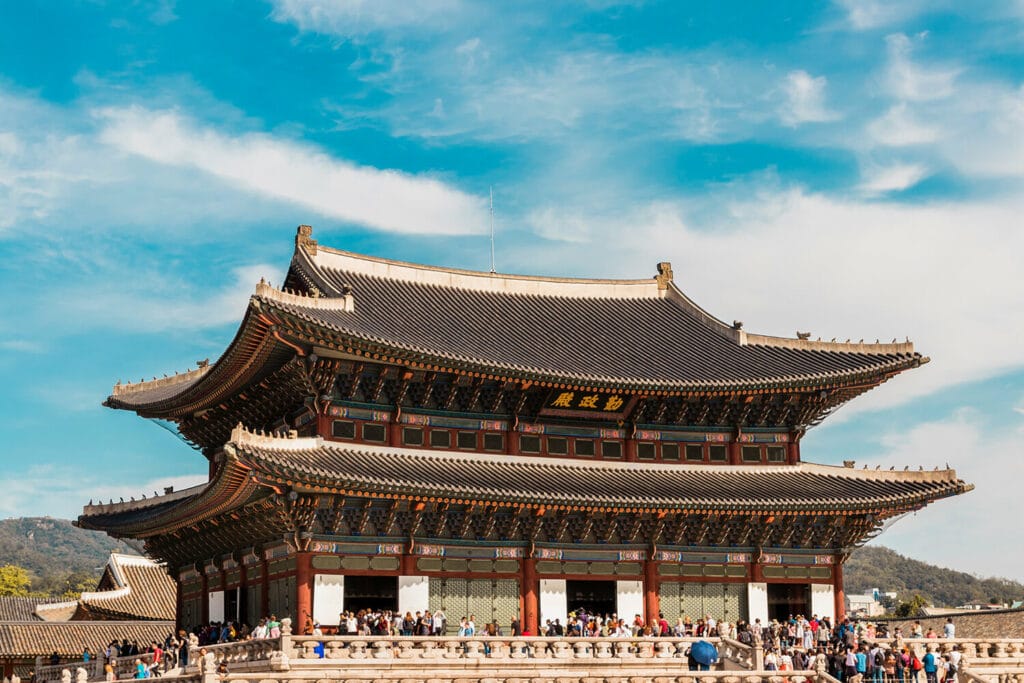South Korea lies surrounded by the sea on the outer edge of Asia. In terms of land area, South Korea ranks among the smallest countries in the world, but there is nothing diminutive about its natural beauty, culture, and customs.
The 8 most interesting places to visit in South Korea
Geo-political facts:
Capital: Seoul
Population: 51 million people in 2016
Land area: 38,000 sq. miles
Currency: South Korean Won. $1.00 equals about $1,100 won.
Motto: “Devotion to the Welfare of Humanity”


Touring Information:
Address: 161, Sajik-ro, Jongno-gu, Seoul
Hours: Open every day except Tuesday.
From November-February the hours are 9am – 5pm and from March-October 9am – 6pm
Cost: Adults pay 3,000 won and children 1,500 won. Children under 6 and seniors 65 or older don’t pay.
English Tours: Every day at 11am, 1:30pm and 3:30pm, English tours begin in front of the information center at Heungnyemun Gate. The tour lasts a little over an hour.
Gyeongbokgung Palace
In 1395, King Taejo designated Seoul as South Korea’s capital and laid the foundation for this exquisite palace. It was designed to be a luxurious home for the royal family, as well as the center for the Korean government. King Taejo eventually named the palace “The Palace Greatly Blessed by Heaven” or Gyeongbokgung.
Over the next centuries, fires and war repeatedly destroyed Gyeongbokgung, but it was always rebuilt and expanded. Today the palace consists of 500 buildings scattered across 40 hectares of land.
However, the Korean government stopped using Gyeongbokgung Palace in the early 1900s. Since then, the palace has become a treasured heritage site. In fact, the palace buildings are great examples of Chinese and Korean Joseon Dynasty architecture and house outstanding history. So, all tourists are welcome to tour the whole palace, as well as its gardens and ponds. They can also browse the National Palace Museum of Korea and the National Folk Museum which are located on the grounds.

Interesting Custom
While you are visiting the palace, you may be asked to remove your shoes before entering certain indoor areas. Going barefoot or wearing slippers, called “sil nae hwa”, indoors is a longstanding Korean tradition rooted in cleanliness and comfort. I say comfort, because many early Korean homes, including the Gyeongbokgung Palace, had heated floors.
Jeonju Hanok Village
Decades ago Korean tradesman built wooden homes and laid cobblestone streets. Therefore, Seoul, Daegu and many other cities in South Korea now have steel skyscrapers, concrete homes and asphalt roads, but there are a few villages, like Jeonju Hanok, which remain lost in time.
Jeonju Hanok, nicknamed “Slow City”, still has many narrow cobblestone streets lined with traditional wooden houses. These homes used to follow ancient traditions and were divided into separate areas for men and women. Now they have been transformed into guesthouses, restaurants and gift shops that open their doors to everyone.


Jeonju Nambu Market
In 1905, the Jeonju Nambu Market was established near the city’s southern gate and vendors began selling fresh produce, fish, oriental spices, silk goods and much more to local shoppers. The market continues to thrive today and now includes various eateries. These food stalls, like many other traditional places to eat in South Korea, serve sticky rice cakes, bibimbap and other tasty oriental dishes every day.
Jeonju Nambu Market Touring Information:
Address: 63, Pungnammun 2-gil, Wansan-gu, Jeonju-si, Jeollabuk-do
Hours: Most stalls in the market are open from 9am-9:30pm
Jeonju’s Deokjin Park
If you are traveling with kids, Jeonju’s Deokjin Park offers a variety of fun things to do. The park includes walking paths, lots of greenery, sports facilities and snack shacks all centered around a lake. There are paddle boats for rent if you want to go out on the lake or you can choose to enjoy the lake’s turtles and jumping fish from the shore.
From mid-July to early August, the lake flaunts an abundance of blooming lotus flowers. The city takes advantage of this opportunity to hold the yearly Dano Changopomul or Water Iris Festival at the park. The festival includes traditional music, dancing and food, as well as folk games, such as ssireum wrestling and a stone battle game called seokjeon.
Deokjin Park Touring Information:
Address: 390, Gwonsamdeuk-ro, Deokjin-gu, Jeonju-si, Jeollabuk-do
Hours: Open day and night
Cost: Free


Interesting Custom
If you eat at Jeonju’s market or any other traditional restaurant in South Korea, you will most likely be served a side dish of kimchi. Kimchi is made by seasoning a variety of vegetables, such as chinese cabbage, daikon radishes, garlic, red peppers and spring onions and then allowing them to ferment for anywhere from two weeks to six months. Kimchi has many health benefits and Koreans serve it at almost every meal.
Seongsan Ilchulbong
Slowly the sun rises above the horizon and bathes the sea, volcanic crater, and onlookers in golden light. This view makes an extinct volcano called Seongsan Ilchulbong one of the best outdoor things to do in South Korea.
Thousands of years ago volcanic activity under the sea pushed tons of volcanic ash and magma almost 600 feet into the air. The mixture of ash and magma hardened into Seongsan Ilchulbong’s tuff cone. Unlike many other volcanic craters, Seongsan Ilchulbong didn’t become a crater lake because its rocks are porous. Instead, it became home to a wide variety of plants, including a number of rare species.
Seongsan Ilchulbong’s unique flora earned it the title of a UNESCO World Heritage site and its exceptional view constantly attracts foreign and local visitors. South Korea’s has other mountains and extinct volcanoes, which also provide outstanding views, but they take hours and experience to climb. Seongsan Ilchulbong and its trails are accessible to everyone – even kids.
Touring Information:
Address: 284-12, Ilchul-ro, Seongsan-eup, Seogwipo-si, Jeju-do
Hours: Open all year round
Cost: Adults 2,000 won and children 1,000 won. Children under 6 and seniors 65 or older don’t pay.


Interesting Custom
Every year from December 31 – January 1, Koreans hold the Seongsan Sunrise Festival in Seongsan Ilchulbong’s crater. Visitors are welcome to participate in the festival’s varied programs that last all night long and then watch the first sunrise of the new year. If you join the festival, be sure to sample some of the traditional fruits and sweets, as well as make your own sun-kissed wishes for the new year.
South Korean Beach festivals
The East, West and South Seas surround South Korea and create beautiful beaches along its coastline. These beaches with their sand, weathered rocks, clear water, seashells and marine life are beautiful, but perhaps they are most valuable to South Korea because of their festivals.
In the first weeks of August, Koreans prepare the beaches along the South Sea for the Great Battle of Hansan Festival. During this festival, trained reenactors ride the waves in armored turtle ships and come ashore to spar with one another. This festival commemorates Admiral Yi Sun-sin and his outstanding victory over the Japanese in 1592.
Touring Information for the Hansan Festival:
Where: Tongyeong Beaches
When: First or second week of August every year.


Pohang International Fireworks festivals
In July, the beaches along the East Sea host the Pohang International Fireworks Festival. This festival includes an international fireworks competition, street parades with colorful floats, and a wide variety of street performances, along with plenty of traditional foods.
Touring Information for the Fireworks Festival:
Where: Yeongildae Beaches
When: The last week of July every year.
Boryeong Mud festival
The Fireworks and Hansan Festivals attract hundreds of visitors, but the Boryeong Mud Festival held on Daecheon Beach welcomes thousands of tourists and Koreans every year.
Also, this two-week festival includes live music, various competitions and an abundance of mud. In fact, the Boryeong mud flats in South Korea are famous for their mineral rich mud, which is used to make cosmetics. Truckloads of this mud are brought to Daecheon Beach for this West Sea Festival, so that everyone can enjoy the experience and health benefits of the mud.
The mud festival has a family zone where children can play safely, as well as the regular zone where visitors are encouraged to wrestle, slide and swim in mud. The festival also includes booths which offer mud massages and beauty treatments, as well as traditional foods and handcrafts.
Touring Information for the Mud Festival:
Where: Daecheon Beach
When: July every year
Cost for the Regular Zone: Adults pay 12,000 won on weekdays and 14,000 won on the weekend. Teenagers pay 10,000 won during the week and 12,000 won on the weekends.
Cost for the Family Zone: Adults pay 4,000 won during the week and 6,000 won on the weekends. Children pay 9,000 won on weekdays and 11,000 won on the weekend. Babies under 3 years of age do not pay.


Interesting Custom
Koreans consume close to 100 lbs of seafood per capita every year. They also share these delicacies with tourists at the beach festivals. A small percentage of this seafood is harvested by “haenyeo” or sea women. These women continue the diving traditions of their mothers and grandmothers. They spend 5-6 hours a day diving 20-30 feet down to the seabed and gathering seafood without any modern breathing equipment.
South Korea has many other great places to visit and things to do, some of them are free and others are paid, but every one of them is worth experiencing.


